Lacustrine Gravity-Flow Deposits and Their Impact on Shale Pore Structure in Freshwater Lake Basins: A Case Study of Jurassic Dongyuemiao Member, Sichuan Basin, SW China
Abstract
1. Introduction
2. Geological Setting
3. Samples and Methods
3.1. Samples
3.2. Methods
3.2.1. Thin-Section Analysis
3.2.2. TOC and X-Ray Analysis
3.2.3. Scanning Electron Microscopy (SEM) Analysis
3.2.4. Low-Temperature N2 Adsorption (LTNA)
3.2.5. Mercury Intrusion Porosimetry (MIP)
4. Results and Discussion
4.1. Lithofacies Types and Characteristics
4.1.1. Lithofacies 1: Shell Skeletal-Bearing Mudrock
4.1.2. Lithofacies 2: Parallel-Laminate Bioclastic Mudrock
4.1.3. Lithofacies 3: Planar and Parallel-Laminated Silty Mudrock
4.1.4. Lithofacies 4: Massive Mudrock
4.2. Division of Gravity-Flow Sedimentary Microfacies
4.2.1. Gravity-Flow Channel
4.2.2. Tongue-Shaped
4.2.3. Lobate
4.2.4. Semi-Deep-Lake–Deep-Lake Mud
4.3. Characterization of Gravity-Flow Deposits
4.4. Depositional Model of Gravity-Flow Deposits
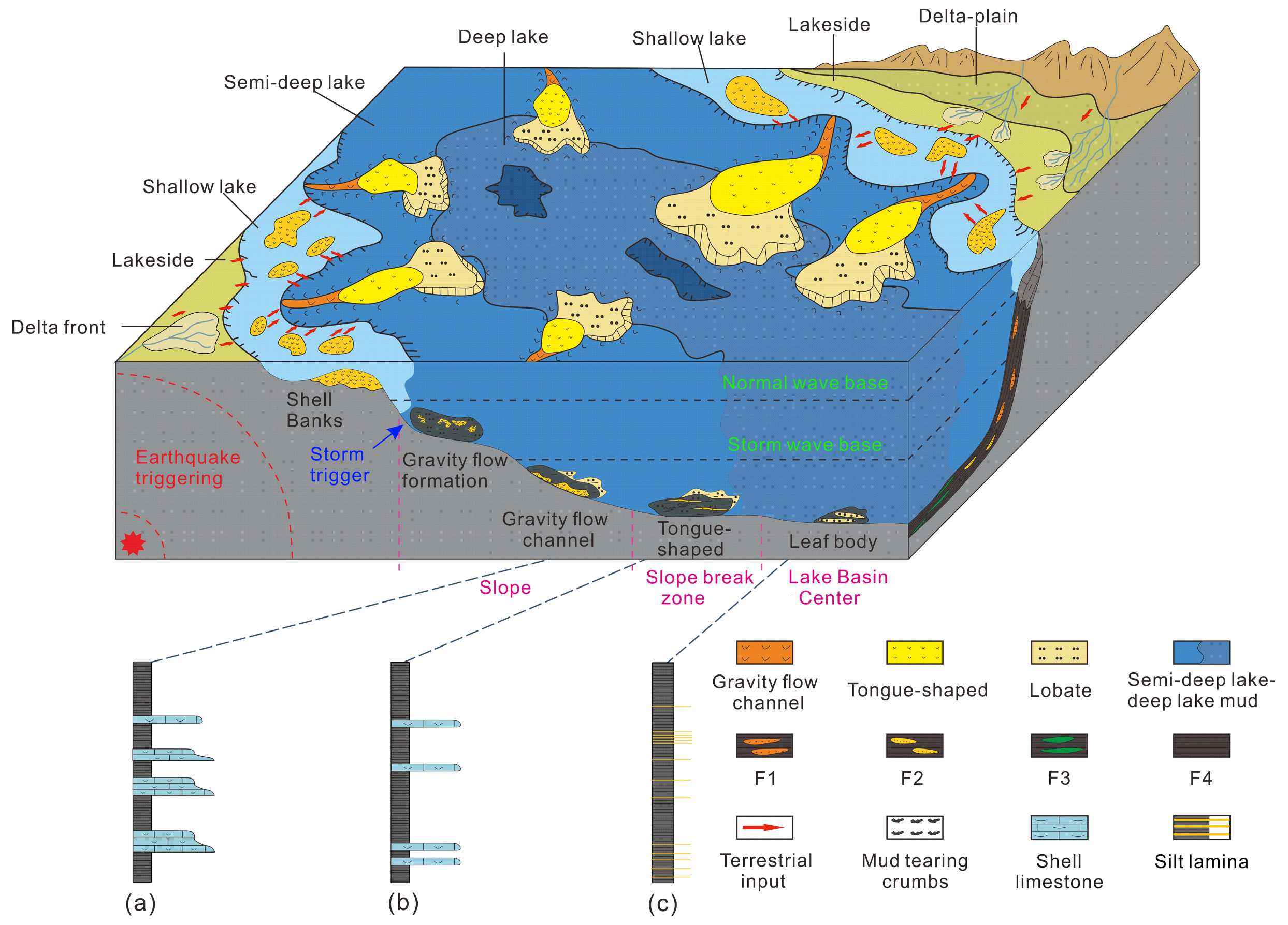
4.5. Pore-Structure Characteristics
4.5.1. Pore Types
4.5.2. Pore Size Distribution
4.6. Effects on Pore Structure
5. Conclusions
Author Contributions
Funding
Institutional Review Board Statement
Informed Consent Statement
Data Availability Statement
Conflicts of Interest
References
- Lu, Q.; Xin, H.; Wang, L.; Luo, S.; Dan, W.; Feng, S. Sedimentary types, characteristics and model of lacustrine fine-grained gravity flow in the Member 7 of Trassic Yanchang Formation in Ningxian area, Ordos Basin. J. Palaeogeogr. 2023, 25, 823–840. [Google Scholar]
- Yang, T.; Cao, Y.; Wang, Y.; Zhang, S. Types, sedimentary characteristics and genetic mechanisms of deep-water gravity flows: A case study of the middle submember in Member 3 of Shahejie Formation in Jiyang depression. Acta Pet. Sinica 2015, 36, 1048–1059. [Google Scholar]
- Zhang, J.; Li, S.; Li, H.; Zhou, X.; Liu, J.; Guo, R.; Chen, J.; Li, S. Gravity flow deposits in the distal lacustrine basin of the 7th reservoir group of Yanchang Formation and deepwater oil and gas exploration in Ordos Basin: A case study of Chang 73 sublayer of Chengye horizontal well region. Acta Pet. Sinica 2021, 42, 570–587. [Google Scholar]
- Middleton, G.; Hampton, M. Sediment Gravity Flows: Mechanics of Flow and Deposition. In Turbidites and Deep-Water Sedimentation; Middleton, G.V., Bouma, A.H., Eds.; Pacific Section SEPM: Los Angles, LA, USA, 1973; pp. 1–38. [Google Scholar]
- Lowe, D. Sediment gravity flows: Their classification and some problems of application to natural flows and deposits. In Geology of Continental Slopes; SEPM Special Publication: Los Angles, LA, USA, 1979; pp. 75–82. [Google Scholar]
- Lowe, D. Depositional models with special reference to the deposits of high-density turbidity currents. J. Sediment. Petrol. 1982, 52, 279–297. [Google Scholar]
- Shen, W.; Jin, X.; Zhao, M.; Liu, X. Discovery and significance of gravity flow deposits of Chang 6 and Chang 7 in Qilicun Oilfield, Ordos Basin. Complex Hydrocarb. Reserv. 2024, 17, 38–43. [Google Scholar]
- Xie, X.; Liu, L.; Tang, W.; Shen, P.; Zhang, J. Current research status and suggestions on the sublacustrine fans in China. China Offshore Oil Gas 2024, 36, 71–83. [Google Scholar]
- Chen, B.; Lin, C.; Ma, C.; Ren, L.; Wang, J.; Li, Z.; Du, K. Types, characteristics and sedimentary model of deep-water gravity flow deposition in the steep slope zone of terrestrial faulted lacustrine basin:a case study of the Es4s submember in the Shengtuo area of Dongying depression. Acta Geol. Sinica 2019, 93, 2921–2934. [Google Scholar]
- Sun, J.; Xue, J.; Hou, G.; Wu, A.; Song, M.; Zhu, F. Sedimentary characteristics and model of sandy debris flow in depression area of lacustrine basin:A case study of the Jurassic Sangonghe formation in the western well Pen-1 sag, Junggar basin. J. China Univ. Min. Technol. 2019, 48, 858–869. [Google Scholar]
- Mutti, E.; Ricci, L. Turbidites of the Northern Apennines: Introduction to Facies Analysis. Int. Geol. Rev. 1972, 20, 125–166. [Google Scholar] [CrossRef]
- Coronel, M.; Isla, M.; Veiga, G.; Mountney, N.; Colombera, L. Anatomy and facies distribution of terminal lobes in ephemeral fluvial successions: Jurassic Tordillo Formation, Neuquén Basin, Argentina. Sedimentology 2020, 67, 2341–2365. [Google Scholar] [CrossRef]
- Zou, C.; Feng, Y.; Yang, Z.; Jiang, W.; Zhang, T.; Zhang, H.; Wang, X.; Zhu, J.; Wei, Q. Fine-grained gravity flow sedimentation and its influence on development of shale oil sweet spot intervals in lacustrine basins in China. Pet. Explor. Dev. 2023, 50, 883–897. [Google Scholar] [CrossRef]
- Shu, Z.; Zhou, L.; Li, X.; Liu, H.; Zeng, Y.; Xie, H.; Yao, M.; Wang, Y. Geological characteristics of gas condensate reservoirs and their exploration and development prospect in the Jurassic continental shale of the Dongyuemiao Member of Ziliujing Formation, Fuxing area, eastern Sichuan Basin. Oil Gas Geology. 2021, 42, 212–223. [Google Scholar]
- Guo, X.; Wei, Z.; Wei, X.; Liu, Z.; Chen, C.; Wang, D. Enrichment conditions and exploration direction of Jurassic continental shale oil and gas in Sichuan Basin. Acta Petrolei. Sin. 2023, 44, 14–27. [Google Scholar]
- Schieber, J.; Souyhard, J. Bedload transport of mud by floccule ripples: Direct observation of ripple migration processes and their implications. Geology 2009, 37, 483–486. [Google Scholar] [CrossRef]
- Cui, H.; Zhu, S.; Shi, Z.; Sun, S.; Chang, Y.; Suo, Y. Sedimentary characteristics and development model of lacustrine fine-grained hybrid sedimentary rocks in the Jurassic Da’anzhai Member, northern Sichuan Basin. J. Palaeogeogr. 2022, 24, 1099–1113. [Google Scholar]
- Yang, P.; Xia, Q.; Yang, C.; Qing, S.; Chen, N. A Study on the Gravity Flow Deposits Characteristics of the Middle Jurassic Lianggaoshan Formation in the Fuling Area of the Sichuan Basin-A Case Study of Well TY1. Petrochem. Ind. Technol. 2024, 31, 283–285. [Google Scholar]
- Owen, M. Distinguishing seismic from storm-triggered event beds in deep-water deposits: A review and recommendations for future studies. Earth-Sci. Rev. 2020, 210, 103340. [Google Scholar]
- Wang, D.; Chen, C.; Liu, Z.; Yang, S.; Liu, M.; Xie, J. Main controlling factors for oil and gas enrichment in Jurassic laminated shale in Fuxing area of Sichuan Basin. Pet. Geol. Exp. 2024, 46, 319–332. [Google Scholar]
- Washburn, E.W. The dynamics of capillary flow. Phys. Rev. 1921, 17, 273–283. [Google Scholar] [CrossRef]
- Liu, H.; Sun, S.; Cao, Y. Lithofacies characteristics and distribution model of fine-grained sedimentary rock in the lower Es3 member, Dongying Sag. Pet. Geol. Recovery Effic. 2017, 24, 1–10. [Google Scholar]
- Hu, D.; Wei, Z.; Liu, R.; Wei, X.; Chen, F.; Liu, Z. Enrichment control factors and exploration potential of lacustrine shale oil and gas: A case study of Jurassic in the Fuling area of the Sichuan Basin. Nat. Gas Ind. 2021, 41, 113–120. [Google Scholar] [CrossRef]
- Lazar, O.; Bohacs, K.; Macquaker, J.; Schieber, J.; Demko, T. Capturing key attributes of fine-grained sedimentary rocks in outcrops, cores, and thin sections: Nomenclature and description guidelines. J. Sediment. Res. 2015, 85, 230–246. [Google Scholar] [CrossRef]
- Mohrig, D.; Ellis, C.; Parker, G.; Whipple, K.; Hondzo, M. Hydroplaning of subaqueous debris flows. Geol. Soc. Am. Bull. 1998, 110, 387–394. [Google Scholar] [CrossRef]
- Harbitz, C.; Parker, G.; Elverhøi, A.; Marr, J.; Mohrig, D.; Harff, P. Hydroplaning of subaqueous debris flows and glide blocks: Analytical solutions and discussion. J. Geophys. Res. Solid Earth 2003, 108, 1. [Google Scholar] [CrossRef]
- De, B.; Engvik, L.; Harbitz, C.; Elverhøi, A. Hydroplaning and submarine debris flows. J. Geophys. Res. Ocean. 2004, 109, 1. [Google Scholar]
- Talling, P. Hybrid submarine flows comprising turbidity current and cohesive debris flow: Deposits, theoretical and experimental analyses, and generalized models. Geosphere 2013, 9, 460–488. [Google Scholar] [CrossRef]
- Song, M.; Xiang, K.; Zhang, Y.; Cai, P.; Liu, J.; Yang, R. Research Progresses on Muddy Gravity Flow Deposits and Their Significances on Shale Oil and Gas: A case study from the 3rd oil-member of the Paleogene Shahejie Formation in the Dongying Sag. Acta Sedimentol. Sin. 2017, 35, 740–751. [Google Scholar]
- Clare, M.; Talling, P.; Challenor, P. Distal turbidites reveal a common distribution for large (>0.1 km3) submarine landslide recurrence. Geology 2014, 42, 263–266. [Google Scholar] [CrossRef]
- Cao, Y.; Yang, T.; Wang, Y.; Zhang, S.; Wang, S.; Zhang, Q.; Wang, X. Types and genesis of deep-water hybrid event beds comprising debris flow and turbidity current. Earth Sci. Front. 2016, 24, 234–248. [Google Scholar]
- Li, Y.; He, D. Evolution of tectonic-depositional environment and prototype basins of the Early Jurassic in Sichuan Basin and adjacent areas. Acta Pet. Sin. 2014, 35, 219–232. [Google Scholar]
- Xu, M.; Wang, F.; Tian, J.; Ren, Z.; Meng, H.; Yu, W.; Wang, J.; Wu, J.; Xiao, Y. Classification of Lacustrine Organic-Rich Mud Shale Petrography and the Depositional Environment: An Example from the Chang 73 Sub-member in the Ordos Basin. Acta Sedimentol. Sin. 2023, 76, 1–24. [Google Scholar]
- Wu, J.; Yuan, Y.; Niu, S. Multiscale characterization of pore structure and connectivity of Wufeng-Longmaxi shale in Sichuan Basin, China. Mar. Pet. Geol. 2020, 120, 104514. [Google Scholar] [CrossRef]
- Lu, J.; Ruppel, S.; Rowe, H. Organic matter pores and oil generation in the Tuscaloosa marine shale. AAPG Bull. 2015, 99, 333–357. [Google Scholar] [CrossRef]
- Chen, F.; Zheng, Q.; Ding, X. Pore size distributions contributed by OM, clay and other minerals in over-mature marine shale: A case study of the Longmaxi shale from Southeast Chongqing, China. Mar. Pet. Geol. 2020, 122, 106479. [Google Scholar] [CrossRef]
- Ross, D.; Bustin, R. The importance of shale composition and pore structure upon gas storage potential of shale gas reservoirs. Mar. Pet. Geol. 2009, 26, 916–927. [Google Scholar] [CrossRef]
- Xu, Q.; Ma, Y.; Liu, B. Characteristics and control mechanism of nanoscale pores in lacustrine tight carbonates: Examples from the Jurassic Da’anzhai Member in the central Sichuan Basin, China. J. Asian Earth Sci. 2019, 178, 156–169. [Google Scholar] [CrossRef]
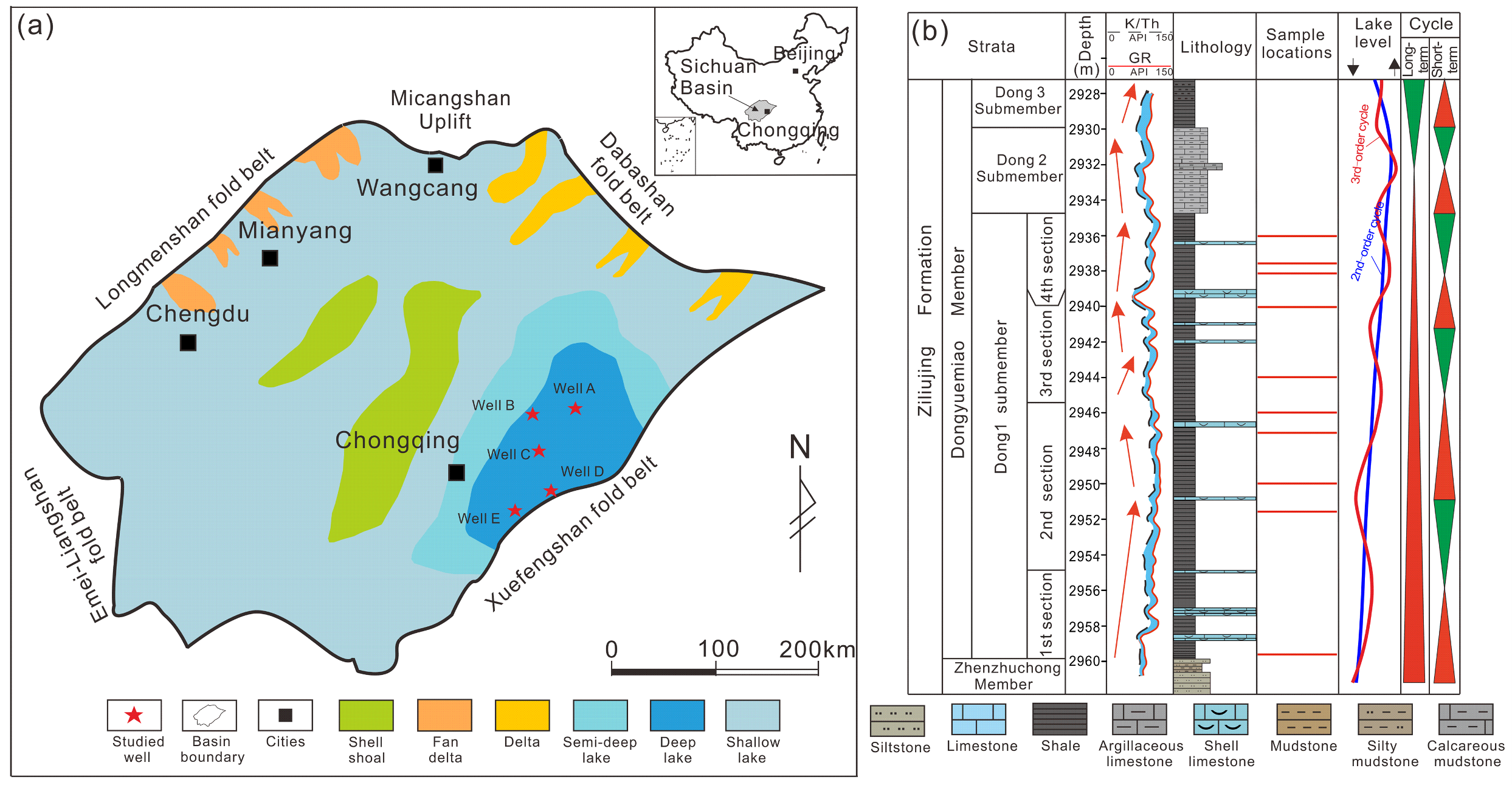
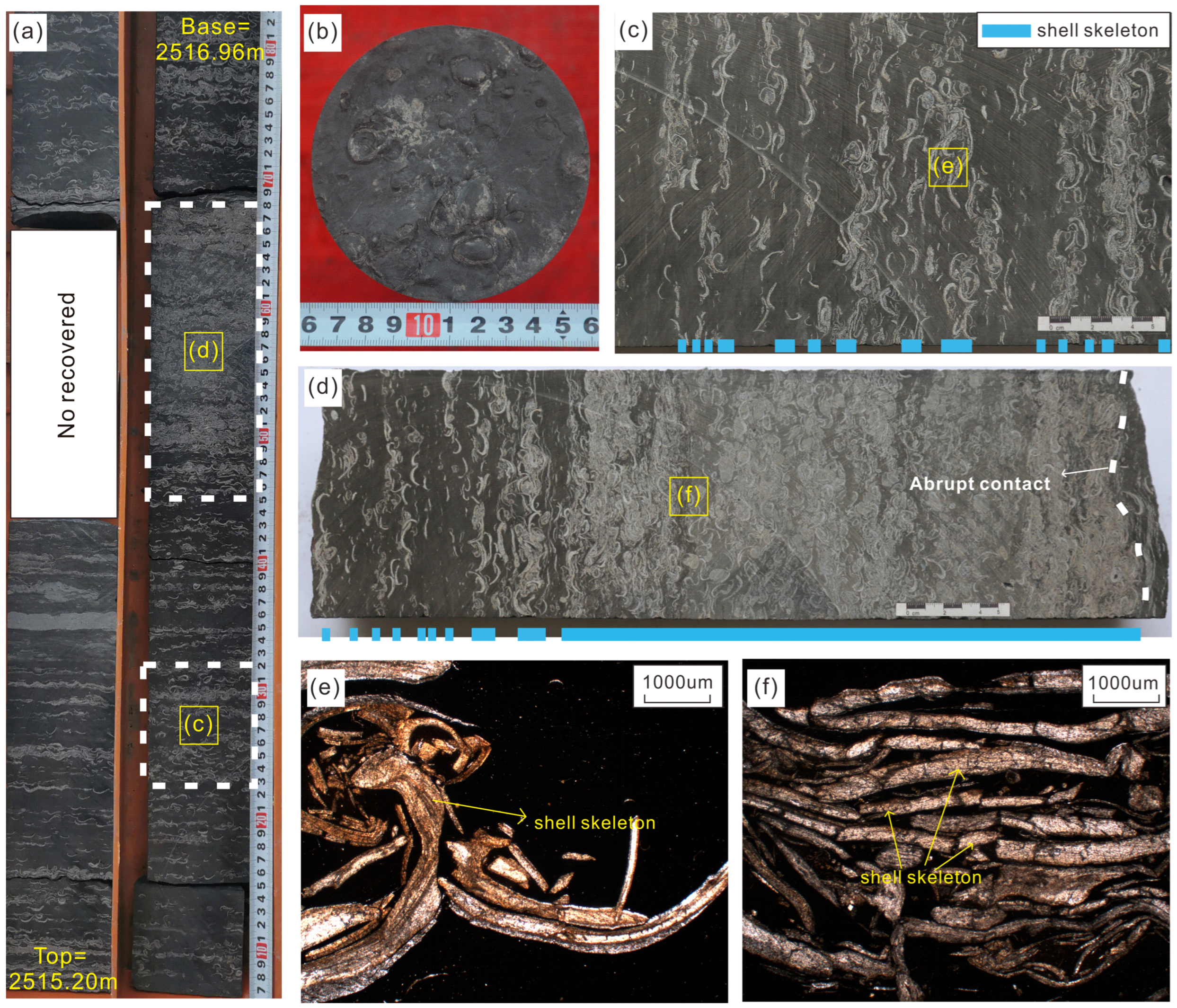
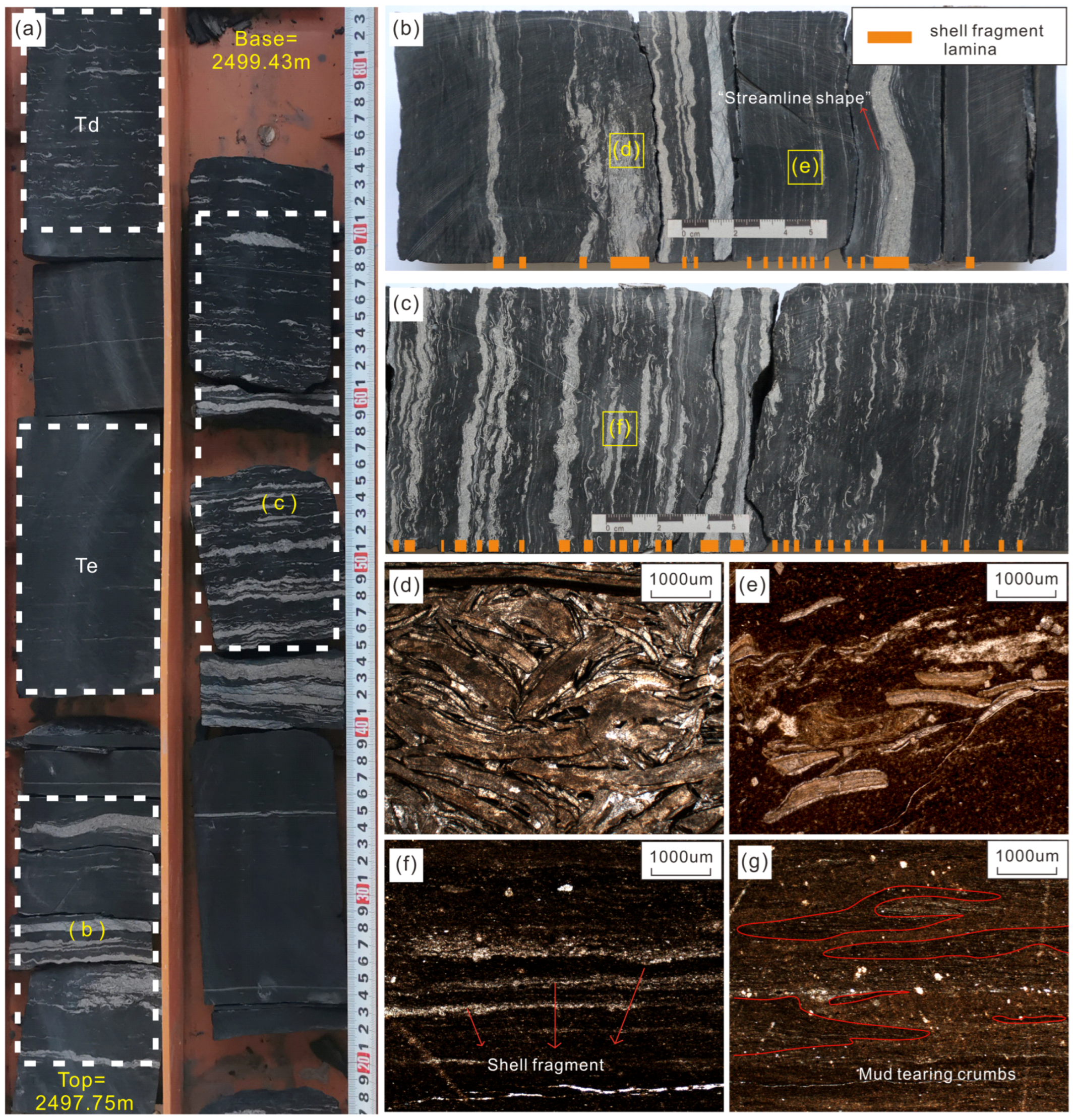
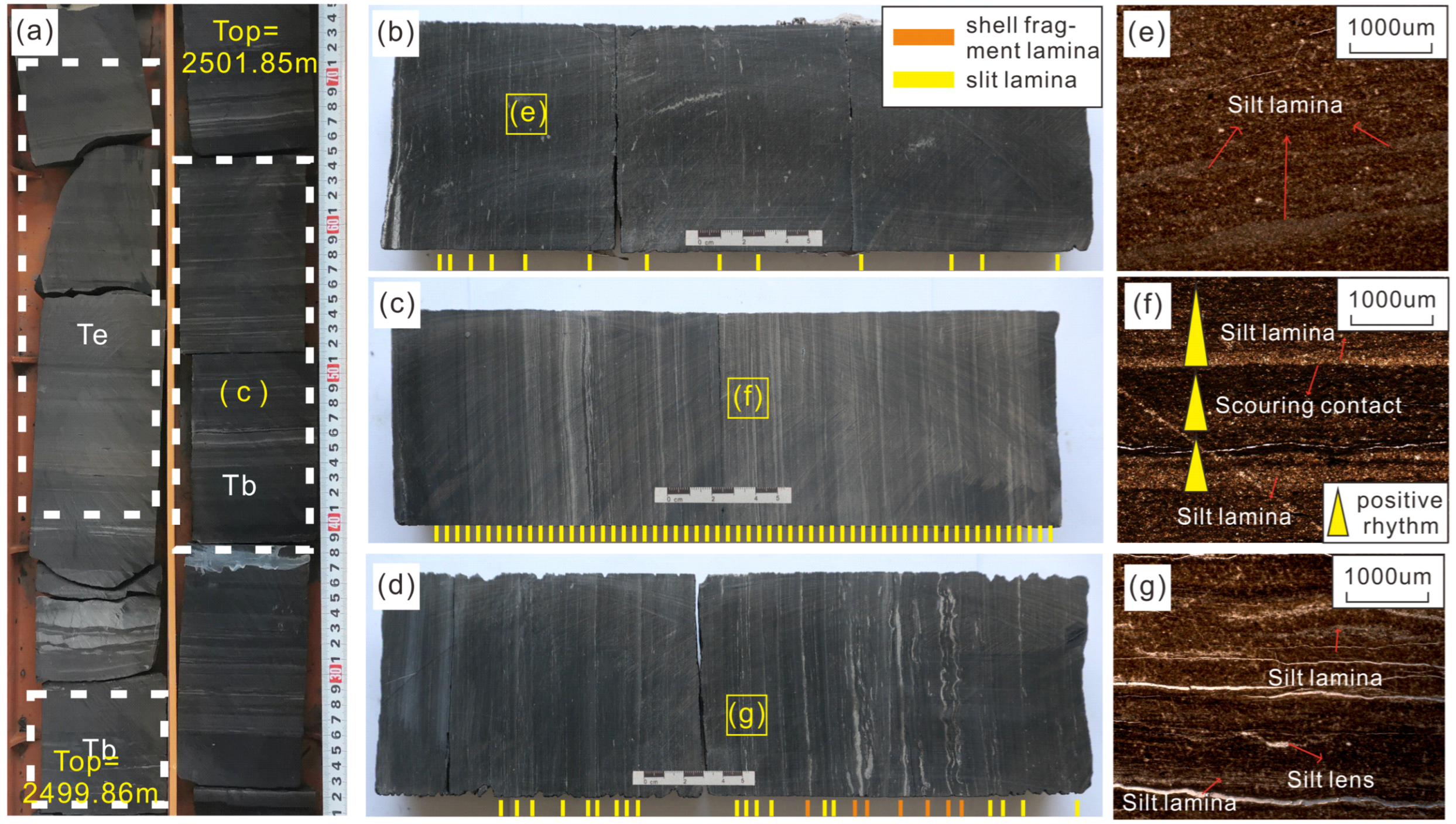

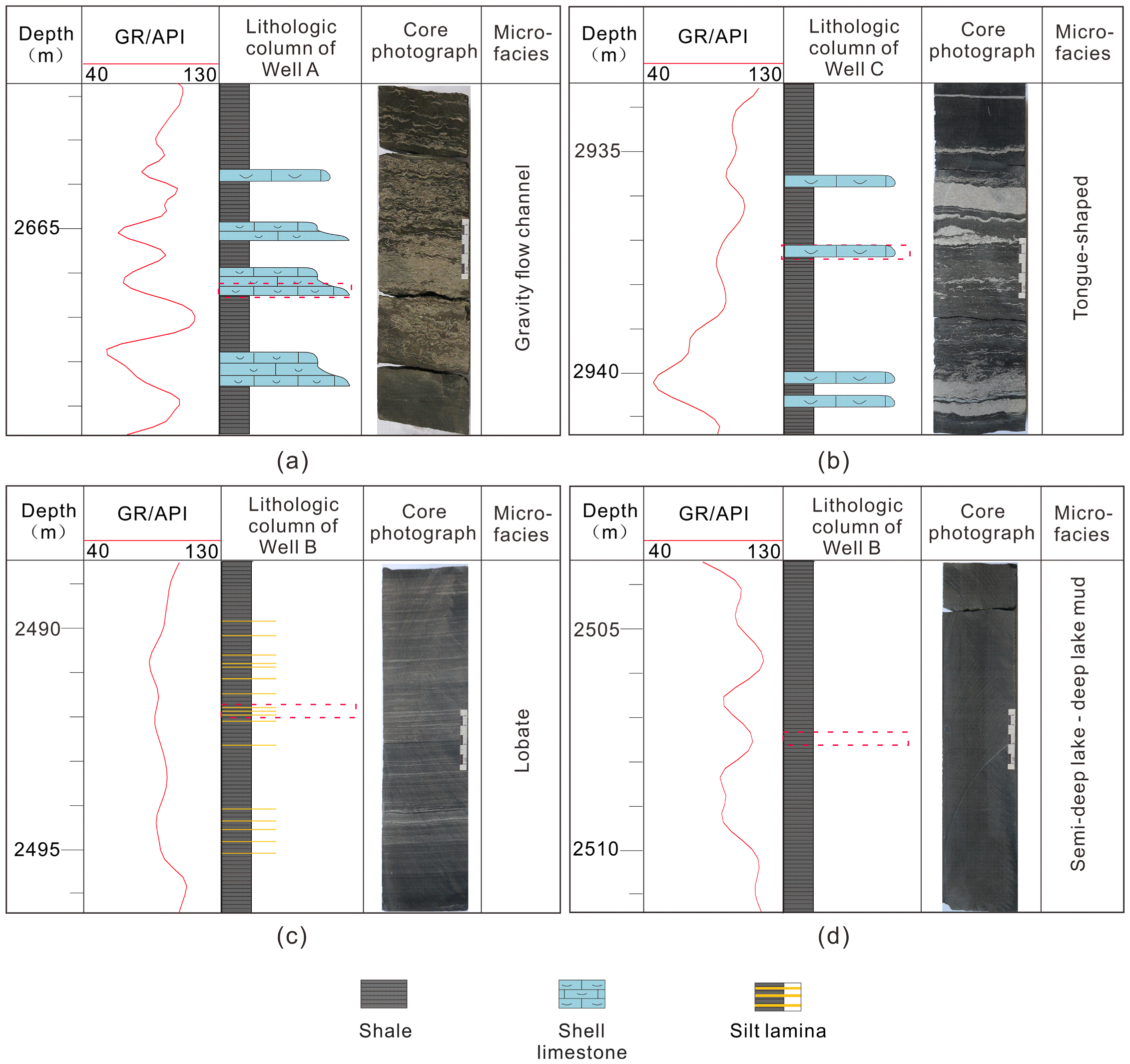
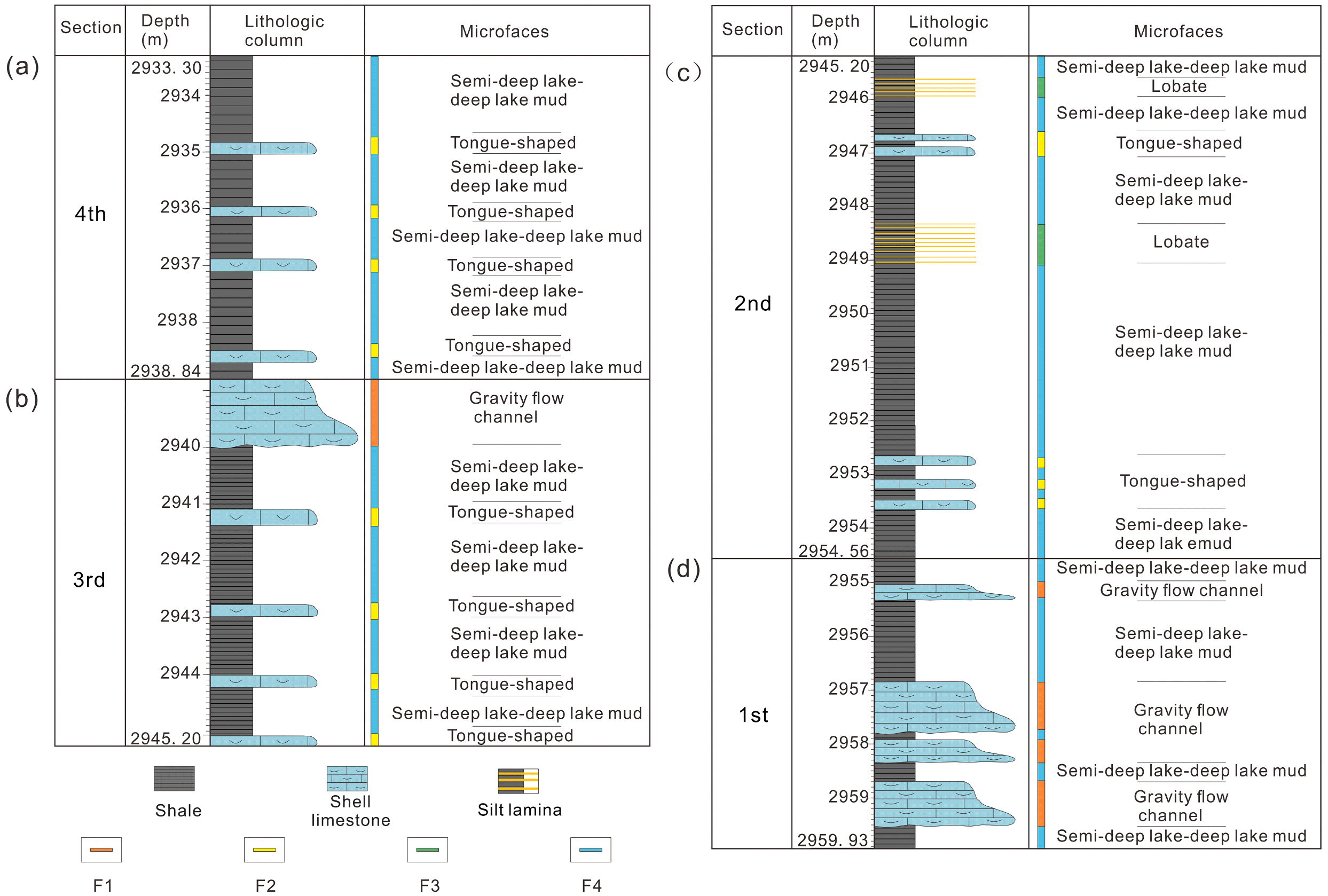
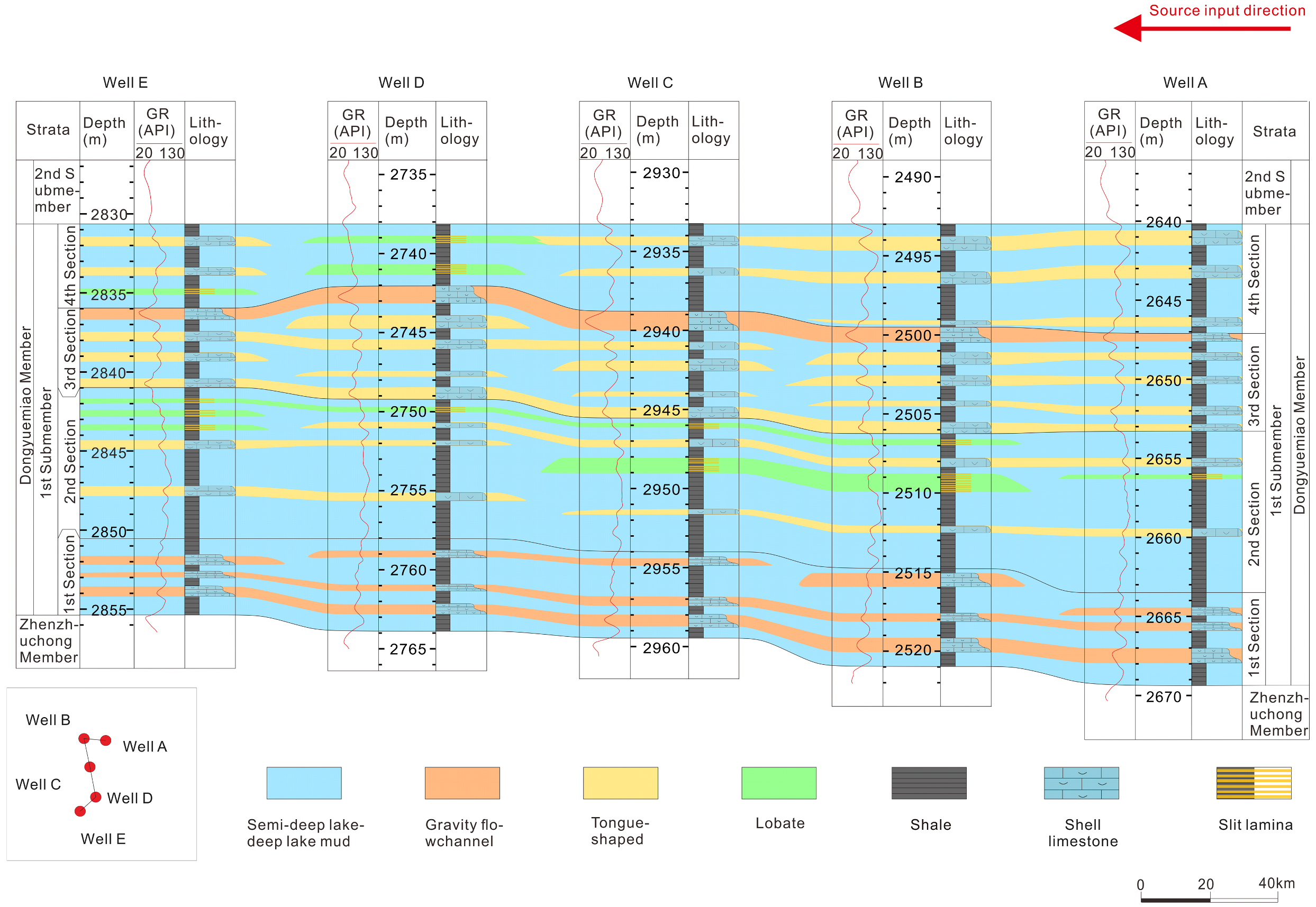
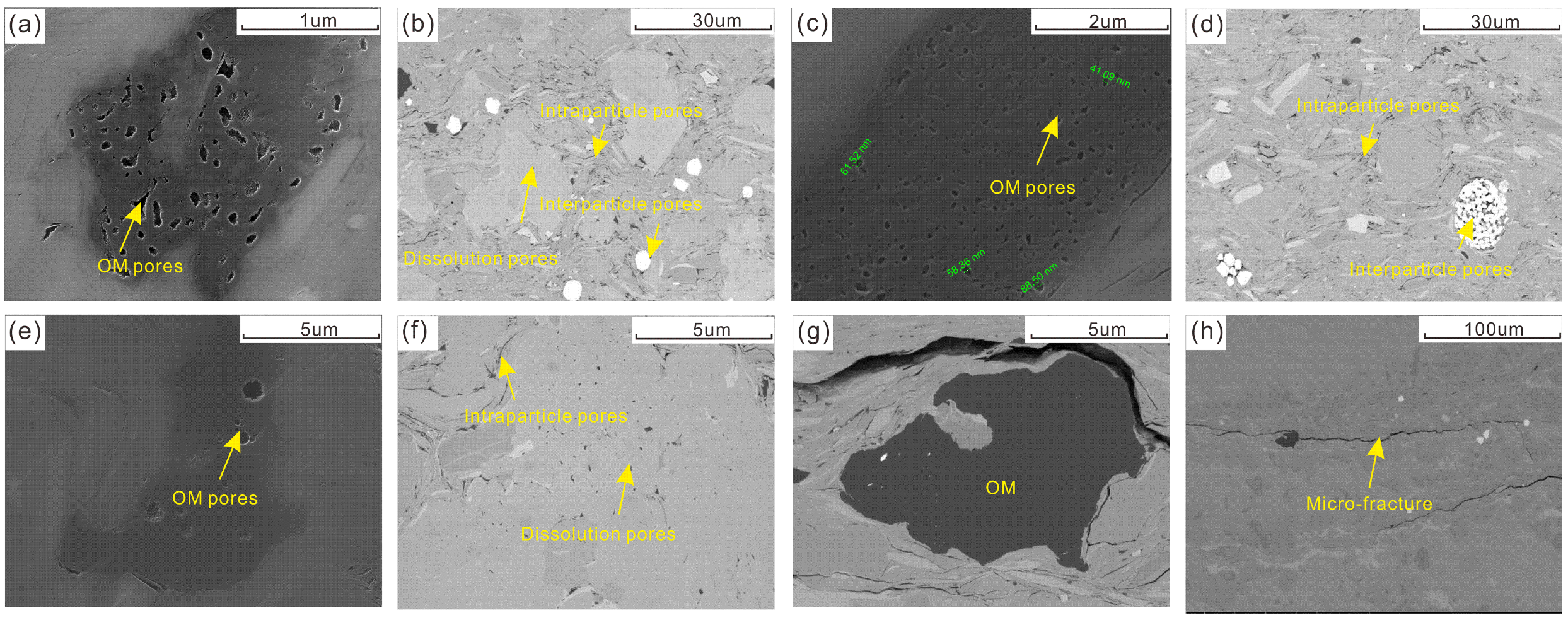
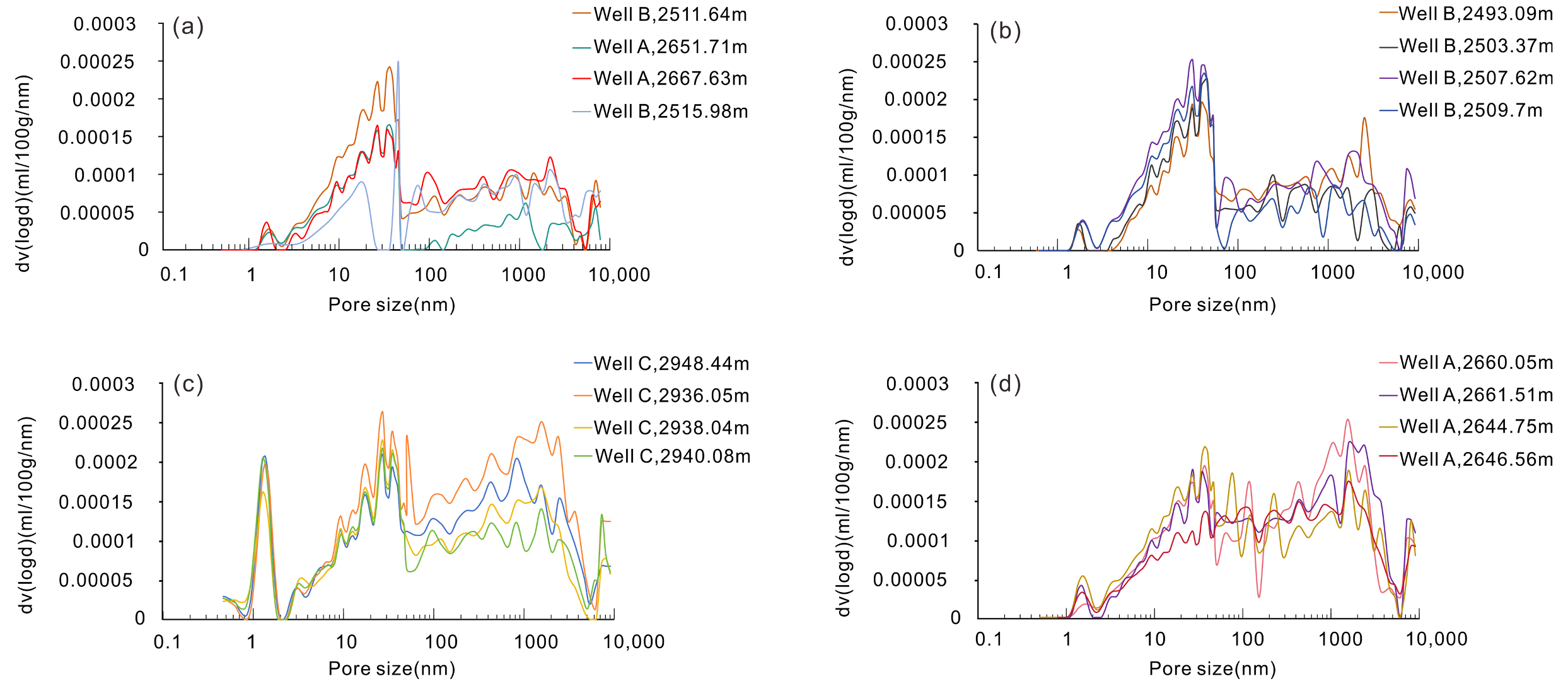
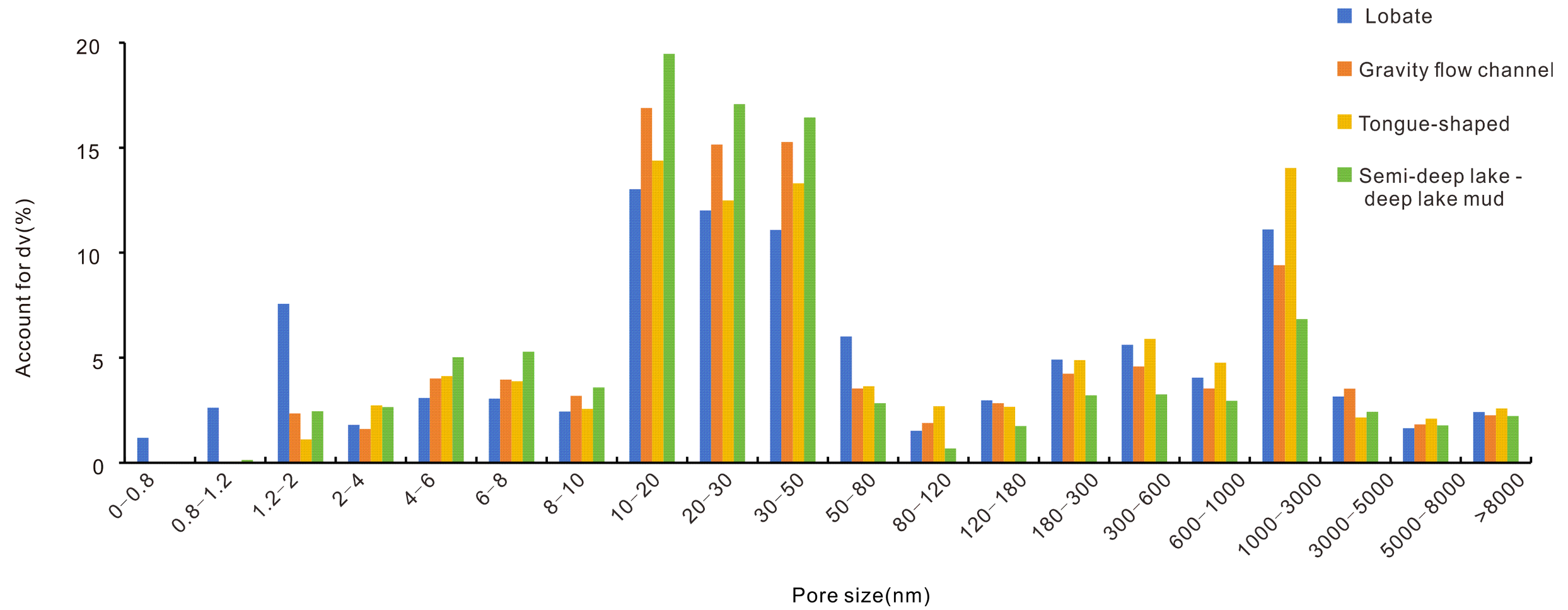

| Lithofacies Types | Sedimentary Characteristics | Genetic Interpretation |
|---|---|---|
| shell skeletal-bearing mudrock (F1) | gray–white shell skeletal floats in the mudstone, abrupt contact between mudstone and shell, the shell skeleton is disorderly distributed | debris flow deposit |
| parallel–laminate bioclastic mudrock (F2) | gray–white laminae, sedimentary deformation occurs in the shell clastic laminae, develop mud-tearing crumbs | |
| planar and parallel-laminated silt mudrock (F3) | gray laminae, scouring contact between silt laminae and mudstone, positive rhythm structure | turbidite deposit |
| massive mudrock (F4) | gray–black mudstone develops carbonized plant debris and framboidal pyrite | suspension deposit |
| Well Name | Depth/m | TOC/% | Mineral Composition/% | ||||||
|---|---|---|---|---|---|---|---|---|---|
| Quartz | K-Feldspar | Plagioclase | Calcite | Dolomite | Pyrite | Clay Minerals | |||
| Well C | 2948.44 | 1.53 | 24.2 | 1.1 | 3.4 | 2.1 | 0.0 | 1.0 | 68.2 |
| Well C | 2936.05 | 2.45 | 24.1 | 1.4 | 3.5 | 0.0 | 0.0 | 1.9 | 69.1 |
| Well C | 2938.04 | 1.68 | 19.4 | 0.9 | 3.5 | 8.5 | 0.0 | 2.3 | 60.8 |
| Well C | 2940.08 | 1.85 | 25.2 | 1.3 | 3.7 | 0.0 | 0.0 | 1.3 | 65.3 |
| Well A | 2660.05 | 1.58 | 26.6 | 1.5 | 3.7 | 6.9 | 0.0 | 0.0 | 61.3 |
| Well A | 2661.51 | 1.83 | 29.6 | 1.0 | 2.8 | 11.2 | 0.0 | 0.7 | 54.7 |
| Well A | 2644.75 | 1.84 | 21.0 | 1.0 | 2.0 | 25.1 | 6.8 | 2.0 | 42.1 |
| Well A | 2646.56 | 1.76 | 18.5 | 0.8 | 1.9 | 29.4 | 3.2 | 2.0 | 40.3 |
| Well B | 2493.09 | 1.53 | 25.0 | 1.5 | 4.5 | 0.0 | 0.0 | 1.5 | 67.5 |
| Well B | 2503.37 | 1.20 | 26.7 | 1.1 | 4.1 | 3.4 | 0.0 | 0.8 | 63.9 |
| Well B | 2507.62 | 1.94 | 28.3 | 0.8 | 3.8 | 10.3 | 0.0 | 0.0 | 56.8 |
| Well B | 2509.7 | 1.89 | 28.4 | 1.2 | 4.5 | 2.6 | 0.0 | 0.0 | 63.3 |
| Well B | 2511.64 | 1.31 | 14.4 | 0.0 | 2.5 | 46.9 | 0.0 | 2.1 | 30.5 |
| Well A | 2651.71 | 1.77 | 19.2 | 0.9 | 2.4 | 29.2 | 3.1 | 2.7 | 38.9 |
| Well A | 2667.63 | 1.98 | 21.9 | 1.1 | 2.5 | 20.9 | 0.0 | 0.0 | 53.6 |
| Well B | 2515.98 | 1.69 | 29.6 | 0.0 | 4.4 | 28.0 | 0.0 | 0.0 | 31.0 |
| Well Name | Depth/m | TOC/% | Clay Mineral Abundance/% | |||
|---|---|---|---|---|---|---|
| Illite | Kaolinite | Chlorite | Illite-Smectite Mixed-Layer | |||
| Well C | 2948.44 | 1.53 | 40 | 14 | 23 | 23 |
| Well C | 2936.05 | 2.45 | 38 | 16 | 27 | 19 |
| Well C | 2938.04 | 1.68 | 46 | 11 | 25 | 18 |
| Well C | 2940.08 | 1.85 | 40 | 15 | 24 | 21 |
| Well A | 2660.05 | 1.58 | 38 | 17 | 29 | 16 |
| Well A | 2661.51 | 1.83 | 36 | 20 | 25 | 19 |
| Well A | 2644.75 | 1.84 | 38 | 22 | 22 | 18 |
| Well A | 2646.56 | 1.76 | 41 | 17 | 25 | 17 |
| Well B | 2493.09 | 1.53 | 45 | 16 | 24 | 15 |
| Well B | 2503.37 | 1.20 | 43 | 15 | 26 | 16 |
| Well B | 2507.62 | 1.94 | 37 | 19 | 30 | 14 |
| Well B | 2509.7 | 1.89 | 43 | 17 | 32 | 8 |
| Well B | 2511.64 | 1.31 | 39 | 22 | 36 | 3 |
| Well A | 2651.71 | 1.77 | 36 | 26 | 26 | 12 |
| Well A | 2667.63 | 1.98 | 36 | 41 | 5 | 18 |
| Well B | 2515.98 | 1.69 | 32 | 24 | 37 | 7 |
| Well Name | Depth/m | Micropore Volume | Mesopore Volume | Macropore Volume |
|---|---|---|---|---|
| Well C | 2948.44 | 0.0013 | 0.0040 | 0.0032 |
| Well C | 2936.05 | 0.0012 | 0.0048 | 0.0045 |
| Well C | 2938.04 | 0.0011 | 0.0042 | 0.0026 |
| Well C | 2940.08 | 0.0013 | 0.0041 | 0.0025 |
| Well A | 2660.05 | 0.0001 | 0.0035 | 0.0028 |
| Well A | 2661.51 | 0.0001 | 0.0032 | 0.0031 |
| Well A | 2644.75 | 0.0002 | 0.0039 | 0.0025 |
| Well A | 2646.56 | 0.0001 | 0.0025 | 0.0026 |
| Well B | 2493.09 | 0.0001 | 0.0034 | 0.0022 |
| Well B | 2503.37 | 0.0001 | 0.0040 | 0.0015 |
| Well B | 2507.62 | 0.0002 | 0.0053 | 0.0021 |
| Well B | 2509.7 | 0.0002 | 0.0048 | 0.0012 |
| Well B | 2511.64 | 0.0001 | 0.0048 | 0.0017 |
| Well A | 2651.71 | 0.0001 | 0.0034 | 0.0006 |
| Well A | 2667.63 | 0.0001 | 0.0032 | 0.0020 |
| Well B | 2515.98 | 0.0001 | 0.0017 | 0.0018 |
Disclaimer/Publisher’s Note: The statements, opinions and data contained in all publications are solely those of the individual author(s) and contributor(s) and not of MDPI and/or the editor(s). MDPI and/or the editor(s) disclaim responsibility for any injury to people or property resulting from any ideas, methods, instructions or products referred to in the content. |
© 2025 by the authors. Licensee MDPI, Basel, Switzerland. This article is an open access article distributed under the terms and conditions of the Creative Commons Attribution (CC BY) license (https://creativecommons.org/licenses/by/4.0/).
Share and Cite
Yuan, Q.; Jiang, Y.; Liu, Z.; Wei, X.; Gu, Y. Lacustrine Gravity-Flow Deposits and Their Impact on Shale Pore Structure in Freshwater Lake Basins: A Case Study of Jurassic Dongyuemiao Member, Sichuan Basin, SW China. Minerals 2025, 15, 473. https://doi.org/10.3390/min15050473
Yuan Q, Jiang Y, Liu Z, Wei X, Gu Y. Lacustrine Gravity-Flow Deposits and Their Impact on Shale Pore Structure in Freshwater Lake Basins: A Case Study of Jurassic Dongyuemiao Member, Sichuan Basin, SW China. Minerals. 2025; 15(5):473. https://doi.org/10.3390/min15050473
Chicago/Turabian StyleYuan, Qingwu, Yuqiang Jiang, Zhujiang Liu, Xiangfeng Wei, and Yifan Gu. 2025. "Lacustrine Gravity-Flow Deposits and Their Impact on Shale Pore Structure in Freshwater Lake Basins: A Case Study of Jurassic Dongyuemiao Member, Sichuan Basin, SW China" Minerals 15, no. 5: 473. https://doi.org/10.3390/min15050473
APA StyleYuan, Q., Jiang, Y., Liu, Z., Wei, X., & Gu, Y. (2025). Lacustrine Gravity-Flow Deposits and Their Impact on Shale Pore Structure in Freshwater Lake Basins: A Case Study of Jurassic Dongyuemiao Member, Sichuan Basin, SW China. Minerals, 15(5), 473. https://doi.org/10.3390/min15050473




